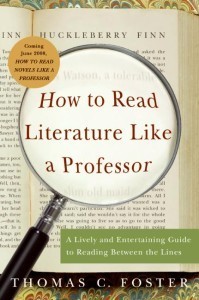Review: How to Read Literature Like a Professor
 I’ve always been a big supporter of literary criticism and using literary devises in my writing. I wrote this article back in 2007 on my first blog project about how to use literary criticism to add theme, symbolism, and deeper meaning to stories. I’ve always enjoyed literature classes and so while wandering through Value Village looking at second hand whatnot, I stumbled across How to Read Literature Like a Professor by Thomas C. Foster. I flipped through it, thinking, this looks pretty interesting, but I already probably know all of this from being in college before.
I’ve always been a big supporter of literary criticism and using literary devises in my writing. I wrote this article back in 2007 on my first blog project about how to use literary criticism to add theme, symbolism, and deeper meaning to stories. I’ve always enjoyed literature classes and so while wandering through Value Village looking at second hand whatnot, I stumbled across How to Read Literature Like a Professor by Thomas C. Foster. I flipped through it, thinking, this looks pretty interesting, but I already probably know all of this from being in college before.
Then, curse it all, I put it back on the shelf!
Naturally when I came to my senses a week later checking the sales, it was gone. By then I’d thought it over enough to be super curious if there’s more things I could learn about literary criticism, and it looked like a good book. Woe! I was too late. Fortunately the library had a copy, but I am still a bit sulky, because it turns out this book is excellent from a writing perspective. Which means I’m going to have to shell out more than the second hand store would have charged me.
The book’s main purpose is to teach readers, mostly high school or college students, how to notice symbolism, theme, and other literary devises in classic literature. It’s conversational tone makes it an easy and pleasant read, and inadvertently, Foster sounds almost like he’s suggesting to us how to add literary depth to one’s writing. Read as a book not for readers but for authors, this is an amazing tool and I definitely want a copy I can keep and use to go over my novels in revision, checking for ways I can flesh them out symbolically.
Some of the great topics he covers in depth are
How to use earlier stories to invoke and depth to a story
The biggest sources for symbolism, Shakespeare, the Bible, fairy tales, and Greek Mythology and why authors use them, why you should use them too
The weather and setting and how to use it
Religious/spiritual themes, politics, violence, sex, illness and their symbolic connotations
Irony and how it works
Yes, this is very basic stuff, things I’ve learned before, but Foster’s straightforwardness has been highly useful. Explanations of, if you want this effect in a book, these are the symbols or parallels that give discerning readers this sort of message. Laying out why it’s critical to draw on previous work when building up a novel and how that enriches the story. Reading the Greek myth chapter, I realized I have Icarus hiding in one of my novels, and reading the chapter on why all stories are part of one great story, I realized why another of my novels desperately needs some Kung Fu in it.
Once I finish this, I plan to check out the sequel, How to Read Novels Like a Professor, to see if I learn anything new there. I might also make myself some checklists for going over every mention of season, weather, meals, and so on to look for symbolic or thematic usefulness.



